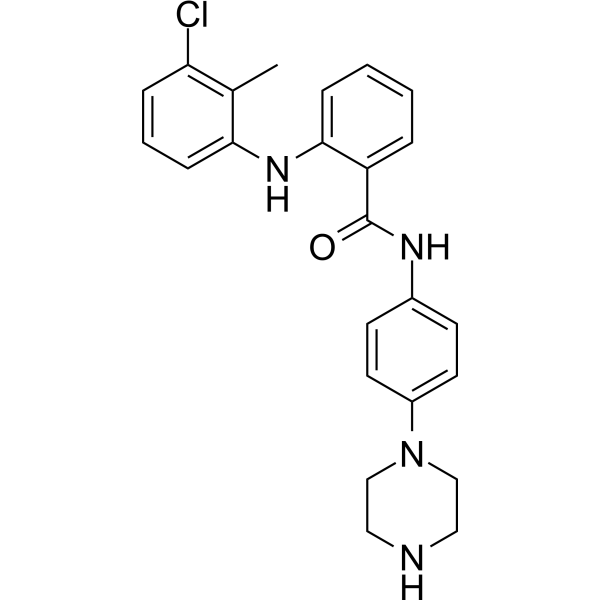产品
编 号:F756305
分子式:C24H25ClN4O
分子量:420.93
分子式:C24H25ClN4O
分子量:420.93
产品类型
规格
价格
是否有货
结构图

CAS No: 2841455-91-0
产品详情
生物活性:
Topo I/COX-2-IN-2 (Compound W10) is a potent dual-target inhibitor of Topo I and COX-2 with IC50 values of 0.90 μM and 2.31 μM, respectively. Topo I/COX-2-IN-2 induces cancer cell apoptosis through the mitochondrial pathway.
体内研究:
Topo I/COX-2-IN-2 (Compound W10) (15 and 30 mg/kg; i.p.; b.i.d for 2 weeks) inhibits tumor growth and shows obvious necrosis on tumor tissue.Topo I/COX-2-IN-2 has acceptable pharmacokinetic properties for intraperitoneal injection and oral administration.Animal Model:Male BALB/c nude mice weighing 20–25 g, HT29 xenograft model
Dosage:15 and 30 mg/kg
Administration:Intraperitoneal injection, twice daily for 2 weeks
Result:30 mg/kg group immediately slowed down the tumor growth rate after administration, and almost completely prevented tumor growth in the later stage, and its tumor growth inhibition (TGI) was 57.86%. 15 mg/kg group showed 40.67% TGI. Showed obvious necrosis on tumor tissue.
Animal Model:250–280 g male SD rats
Dosage:100 mg/kg and 30 mg/kg
Administration:Intragastric administration (100 mg/kg) or intraperitoneal injection (30 mg/kg) (Pharmacokinetics Study)
Result:Pharmacokinetic data of Topo I/COX-2-IN-2 (W10) in vivoaComp.Dose(mg/kg) Route T1/2(h) Tmax(h) Cmax(μg/mL) AUC0-t(μg?h/mL)
Topo I/COX-2-IN-2100p.o.8.87 ± 1.923.67 ± 0.582.00 ± 0.4124.81 ± 5.76
30i.p.4.27 ± 0.220.28 ± 0.051.60 ± 0.345.41 ± 0.20
a Topo I/COX-2-IN-2 was administered to 6 SD rats with different administration methods and doses, and the serum concentration was analyzed. The analysis method is the linear trapezoidal PKsolver 2.0 computer program of the non-compartmental model. All the data are from the above 6 rats, and the data are represented by the mean and standard deviation.
体外研究:
Topo I/COX-2-IN-2 (Compound W10) (0-30 μM) shows good toxicity against cancer cells.Topo I/COX-2-IN-2 forms an ionic bonding interaction with DA13 of DNA to improve Topo I inhibition.Topo I/COX-2-IN-2 (0-9 μM, 24 h) arrests cell cycle of HT29 and RKO at G1/G0 phase, induces apoptosis in HT29 and RKO cells through the mitochondrial pathway, and inhibits abnormal activation of the NF-κB/IκB pathway. .
Topo I/COX-2-IN-2 (Compound W10) is a potent dual-target inhibitor of Topo I and COX-2 with IC50 values of 0.90 μM and 2.31 μM, respectively. Topo I/COX-2-IN-2 induces cancer cell apoptosis through the mitochondrial pathway.
体内研究:
Topo I/COX-2-IN-2 (Compound W10) (15 and 30 mg/kg; i.p.; b.i.d for 2 weeks) inhibits tumor growth and shows obvious necrosis on tumor tissue.Topo I/COX-2-IN-2 has acceptable pharmacokinetic properties for intraperitoneal injection and oral administration.Animal Model:Male BALB/c nude mice weighing 20–25 g, HT29 xenograft model
Dosage:15 and 30 mg/kg
Administration:Intraperitoneal injection, twice daily for 2 weeks
Result:30 mg/kg group immediately slowed down the tumor growth rate after administration, and almost completely prevented tumor growth in the later stage, and its tumor growth inhibition (TGI) was 57.86%. 15 mg/kg group showed 40.67% TGI. Showed obvious necrosis on tumor tissue.
Animal Model:250–280 g male SD rats
Dosage:100 mg/kg and 30 mg/kg
Administration:Intragastric administration (100 mg/kg) or intraperitoneal injection (30 mg/kg) (Pharmacokinetics Study)
Result:Pharmacokinetic data of Topo I/COX-2-IN-2 (W10) in vivoaComp.Dose(mg/kg) Route T1/2(h) Tmax(h) Cmax(μg/mL) AUC0-t(μg?h/mL)
Topo I/COX-2-IN-2100p.o.8.87 ± 1.923.67 ± 0.582.00 ± 0.4124.81 ± 5.76
30i.p.4.27 ± 0.220.28 ± 0.051.60 ± 0.345.41 ± 0.20
a Topo I/COX-2-IN-2 was administered to 6 SD rats with different administration methods and doses, and the serum concentration was analyzed. The analysis method is the linear trapezoidal PKsolver 2.0 computer program of the non-compartmental model. All the data are from the above 6 rats, and the data are represented by the mean and standard deviation.
体外研究:
Topo I/COX-2-IN-2 (Compound W10) (0-30 μM) shows good toxicity against cancer cells.Topo I/COX-2-IN-2 forms an ionic bonding interaction with DA13 of DNA to improve Topo I inhibition.Topo I/COX-2-IN-2 (0-9 μM, 24 h) arrests cell cycle of HT29 and RKO at G1/G0 phase, induces apoptosis in HT29 and RKO cells through the mitochondrial pathway, and inhibits abnormal activation of the NF-κB/IκB pathway. .
产品资料

